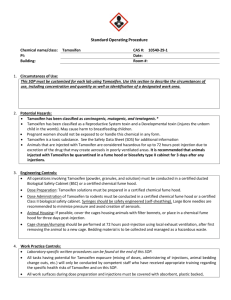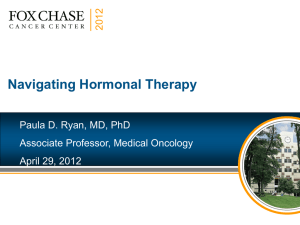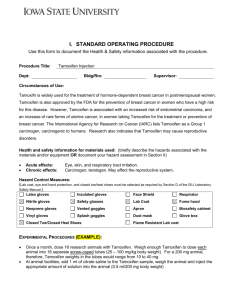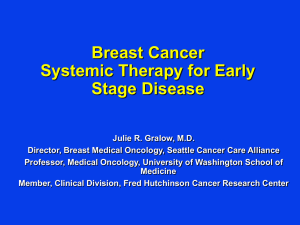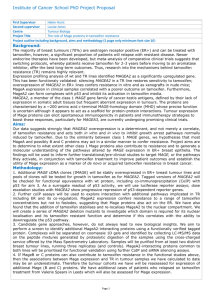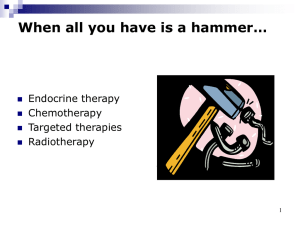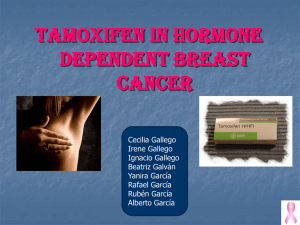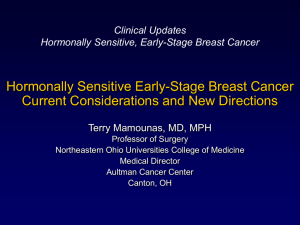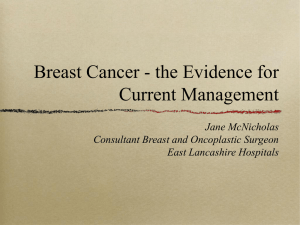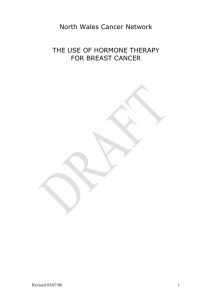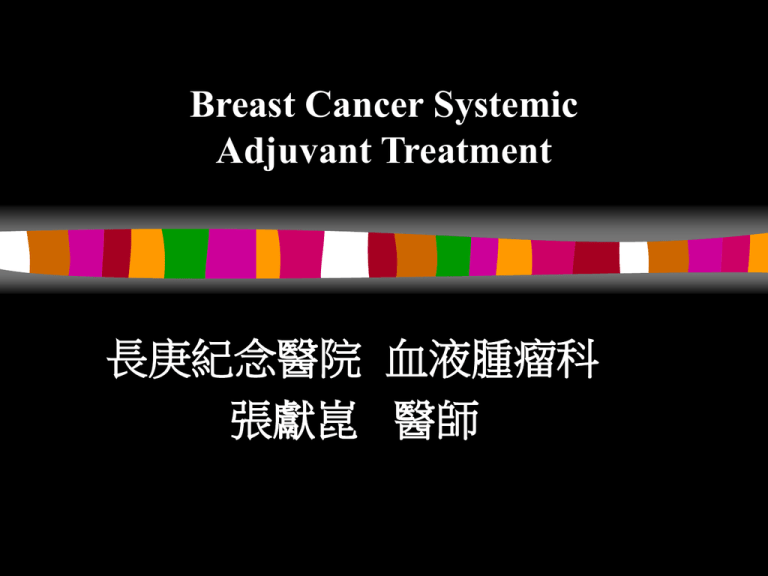
Breast Cancer Systemic
Adjuvant Treatment
長庚紀念醫院 血液腫瘤科
張獻崑 醫師
Early Disease
Adjuvant
therapy
Advanced Disease
≒30%
Node
negative
Stage 1
Stage 4
Node
positive
≒50%
Incurable!
70%
Stage 2
Stage 3
Endocrine therapy
and/or Chemotherapy
± Biologic therapies
More aggressive
medical
treatment !!!
BREAST CANCER
Determinants of Recurrence
Tumor size
Lymph node involvement
Histological differentiation
Tumor estrogen- and progesterone-receptor status
Lymphatic/blood vessel invasion
Specific factors:
—
—
—
Ploidy or DNA index
Proliferation factors (s-phase fraction, Ki-67)
Oncogene amplification/expression (HER-2/neu)
Patient’s Breast Cancer History
2007/11
Left breast cancer s/p left partial mastectomy and dissection of
axillary lymphatics
Stage IIA (T1cN1M0) , Grade III invasive ductal carcinoma
ER (3+), PR (3+) and Her-2 (1+)
Age:36 y/o, Premenopausal
2007/12 Plan of Adjuvant therapies
Chemotherapy :
Radiotherapy :
Endocrine therapy :
Breast Cancer Adjuvant Treatment
--- About Chemotherapy
Polychemotherapy for Early Breast Cancer :
an overview of the randomized trials ( I )
TABLE 1. Adjuvant drug therapy: percentage reduction in the annual
odds of either recurrence or death
Patient
Age (y)
< 40
40-49
50-59
60-69
•
•
•
Therapy
C/T vs. none
C/T vs. none
C/T vs. none
C/T vs. none
Reduction in Annual
Odds of Recurrence (%)
37 + 7
35 + 5
22 + 4
18 + 4
Reduction in Annual
Odds of Death (%)
27 + 8
27 + 5
14 + 4
8+4
C/T: polychemotherapy
Polychemotherapy reduce 20% annual odds of contra-lateral breast cancer
Adapted from EBCTCG Lancet 1998;352:930-42
Polychemotherapy for Early Breast Cancer :
an overview of the randomized trials ( III )
-- Anthracycline-containing v.s CMF
TABLE 2. Adjuvant drug therapy: Anthracycline-containing
regimens versus CMF
Adjuvant Therapy
Recurrence
Death
A-containing vs.
A-containing vs.
CMF
CMF
Proportion
Reduction
(%)
Absolute
Reduction
(%)
12 + 4
11 + 5
3.2 +1. 5
2.7 + 1.4
*A-containing: Anthracycline-containing regimens
*Adapted from EBCTCG Lancet 1998;352:930-42
Evolution of Chemotherapy
in Node-Positive Disease
CMF
AC
=
Milan
=
B-15
CEF
FAC
TC
MA.5
GEICAM
US9735
TAC
AC-T
BCIRG 001
E1199
FEC50
ICCG
FEC100
AC-P
FASG05
C9344
B-28
AC-Pw AC2w-P2w FEC-T FEC-Pw
PACS01
G9906
E1199
C9741
Polychemotherapy for Early Breast Cancer :
an overview of the randomized trials ( II )
-- Node Positive and Node Negative
Breast Cancer Adjuvant Treatment
--- About Hormone Therapy
Mode of Action of Estradiol (Full Agonist)
Estradiol
E
+ ER
AF2
E
E
Receptor
AF1 dimerization
Coactivator
E
AF1
Nuclear
localization of
fully active ER
to ERE
AF1 +
AF2
ACTIVE
E
ERE
RNA
POLII
Coactivator
FULLY
ACTIVATED
TRANSCRIPTION
(tumor cell
division)
AF1 and AF2
recruit
coactivators
Adapted from: Wakeling AE. Endocr-Relat Cancer 2000; 7: 17–28.
Mechanisms of Action of
Hormonal Therapies
Block estrogen action
– Tamoxifen
Block estrogen synthesis
– Ovarian ablation (premenopausal)
– Inhibition of aromatase (postmenopausal)
Mode of Action of Tamoxifen
Tamoxifen
T
+ ER
T
T
T
T
ERE
Coactivator
AF1
AF1
RNA
POLII
PARTIALLY
INACTIVATED
TRANSCRIPTION
(reduced rate of
tumor cell
division)
Adapted from: Wakeling AE. Endocr-Relat Cancer 2000; 7: 17–28.
Tamoxifen Response in MBC
雌激素接受體
ER
PR
+
+
+
+
-
療效
病人數
有效數 / 全部人數
71%
32%
53%
9%
From Clark GM, McGuire WL:Breast Cancer Res Treat 3:157-163,1983.
188/263
61/189
8/15
16/171
Tamoxifen for Early Breast Cancer:
an overview of the randomized trials
TABLE 5. Duration of Tamoxifenn Adjuvant Therapy on Percentage
Reduction in the Annual Odds of Either Recurrence or Death
Group
Tamoxifen 1 y
< 50
50-59
All
Tamoxifen 2 y
< 50
50-59
All
Tamoxifen 5 y
< 50
50-59
All
•
Reduction in Annual
Odds of Recurrence (%)
Reduction in Annual
Odds of Death (%)
2+7
28 + 6
20 + 3
-2 + 8
21 + 6
11 + 3
14 + 5
32 + 4
29 + 3
10 + 6
19 + 5
17 + 3
45 + 8
37 + 6
47 + 3
32 + 10
11 + 8
26 + 4
Adapted from EBCTCG Lancet 1998;351:1451-67
Tamoxifen for Early Breast Cancer: an
overview of the randomized trials
(Node positive and Node negative)
Ovarian Ablation in Early Breast Cancer:
an overview of the randomized trials ( I )
TABLE 6. Meta-analysis of the Effect of Ovarian Ablation
Group
Reduction in
Annual Odds
of Recurrence (%)
Ovarian ablation vs. no adjuvant therapy (age < 50)
Ovarian ablation + chemotherapy vs chemotherapy
Adapted from EBCTCG Lancet 1996;348:1189-96
25 + 7
10 + 9
Reduction
Annual Odds
of Death (%)
24 + 7
8 + 10
Ovarian Ablation in Early Breast Cancer:
an overview of the randomized trials ( II )
-- Node Positive and Node Negative
Selective Versus Nonselective
Aromatase Inhibition
Cholesterol
Multiple steps involving P-450 enzymes and production of
steroid intermediates
Selective Inhibitors
Nonselective Inhibitors
Aldosterone
Cortisol
Androstenedione
Testosterone
Estrone
Estradiol
Federman, DD: The Adrenal. Dale DC, Federman DD, eds. In: Scientific American Medicine.
Section 3. Subsection IV. ©1997 Scientific American Inc. All rights reserved.
ATAC Trial Design
Postmenopausal women with invasive breast cancer
Completion of primary therapy*
Randomization 1:1:1 for 5 years
Anastrozole 1mg od
Anastrozole placebo
Anastrozole 1mg od
+
+
+
Tamoxifen placebo
Tamoxifen 20mg od
Tamoxifen 20mg od
Regular follow-up monitoring adverse events
Trial endpoints
* Surgery + radiotherapy + chemotherapy
(Patients may start trial therapy while still receiving radiotherapy)
+
Table of First Events in ITT Population
Tamoxifen
(n=3116)
Combination
(n=3125)
317
379
383
67
83
81
156
181
202
Contralateral (invasive)
9
30
23
Contralateral (DCIS)
5
3
5
Death — breast cancer
2
1
2
Death — other reason
78
81
70
Anastrozole
(n=3125)
First event
Locoregional
Distant
Kaplan–Meier Curves of Disease-free Survival
in Receptor-positive Population
100
Proportion event free (%)
*
95
Anastrozole
Tamoxifen
90
Combination
85
AN vs TAM
Comb vs TAM
80
HR
95.2% CI
p-value
0.78
1.02
0.65–0.93
0.87–1.21
0.0054
0.7786
0
0
6
12
18
24
Time to event (months)
Curves truncated at 42 months
30
36
42
Trial Design: types of adjuvant trial
Randomisation
Tamoxifen
AI
Initial adjuvant trial
Randomisation
2-3 years’ prior
tamoxifen
Switching trial
Tamoxifen
AI
Randomisation
AI
5 years’ prior tamoxifen
Extended adjuvant trial
Placebo
Randomisation
Tamoxifen
AI
Initial and sequencing trial
AI
Tamoxifen
Tamoxifen
AI
0
AI, aromatase inhibitor
Time (years)
5
Patient’s Breast Cancer History
2007/11 Age:36 y/o, Premenopausal
Left breast cancer s/p left partial mastectomy and dissection of
axillary lymphatics
Grade III invasive ductal carcinoma, stage IIA (T1cN1M0) ,
ER (3+), PR (3+) and Her-2 (1+)
2007/12~2010/07 Adjuvant therapies
Chemotherapy : Epirubicin, 5-FU, and cyclophosphamide (FE90C) x
4 cycles Taxotere+CDDP x 4 cycles
Radiotherapy (2008/6~2008/7)
Tamoxifen (20mg/day) since 2008/6/3 2010/8/6
Arimidex (1mg/day) since 2010/8/31 2011/3
Side Effect of Tamoxifen
Hot flashes
Thrombo-embolic disease
Endometrial Malignancy
—
—
Endometrial cancer
Uterine sarcoma
Tamoxifen Related Endometrial Malignancy
Endometrial Cancer
-- P-1 study: Tamoxifen chemo-preventive trial
in high risk papulation
Tam. Gr.:53 cases ; Placebo: 17 cases
Risk Ratio: 3.28
Presentation: Vaginal bleeding
67 cases: FIGO stage I
Exclusively age > 50 y/o
-- NSABP B-14: Tamoxifen adjuvant trial in N(-) HR(+) BC
Annual hazard rate of endometrial cancer
Tam. Gr.:1.6/1000 ; Placebo: 0.2/1000
Relative Risk : 7.5
(population-based rate from SEER: relative risk: 2.2)
Cumulative hazard rate (5yr): 6.3/1000
21/24 cases: FIGO stage I
Tamoxifen Related Endometrial Malignancy
Uterine sarcoma --- SEER database
39,541 BC pts (Dx 1980~2000) treated with Tamoxifen
v.s.
General Population :
Uterine corpus cancer relative risk [O/E] ratio: 2.17
Malignant Mixed Mullerian Tumors: O/E ratio= 4.62
Endometrial adenocarcinoma :
O/E ratio= 2.07
Recommendations for Monitoring
Women on Tamoxifen (ACOG)
Premenopausal without known increased risk of uterine cancer:
no additional monitoring beyond routine gynecologic care
Postmenopausal :
annual gynecologic examination
Monitoring for symptoms of endometrial hyperplasia or cancer
Investigate any abnormal vaginal symptoms
Limit tamoxifen use to 5-years duration
Atypical endometrial hyperplasia:
reassess tamoxifen use and appropriate gynecologic
management
Hysterectomy in women with atypical endometrial hyperplasia
whom tamoxifen therapy must be continued
Thank you for your attention


